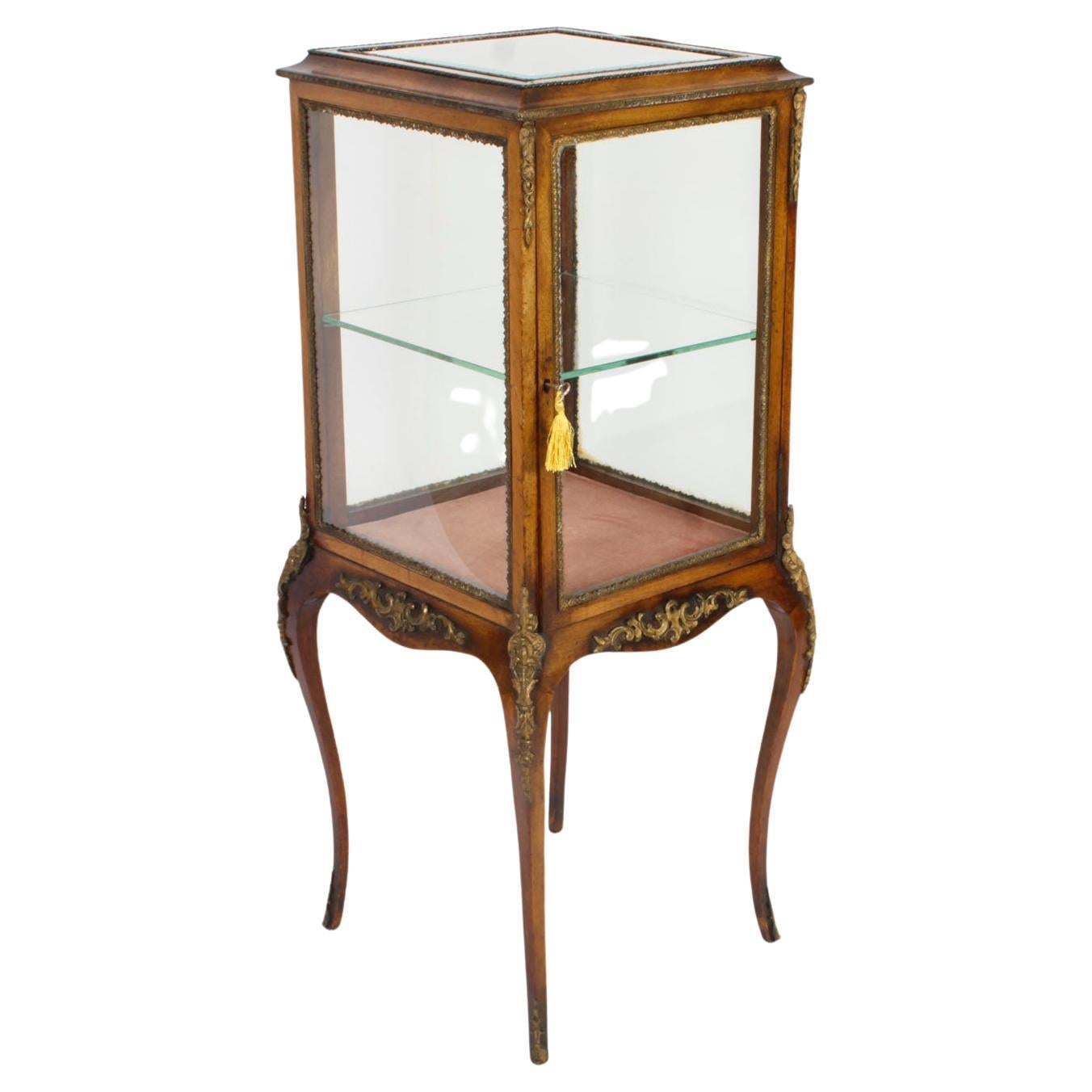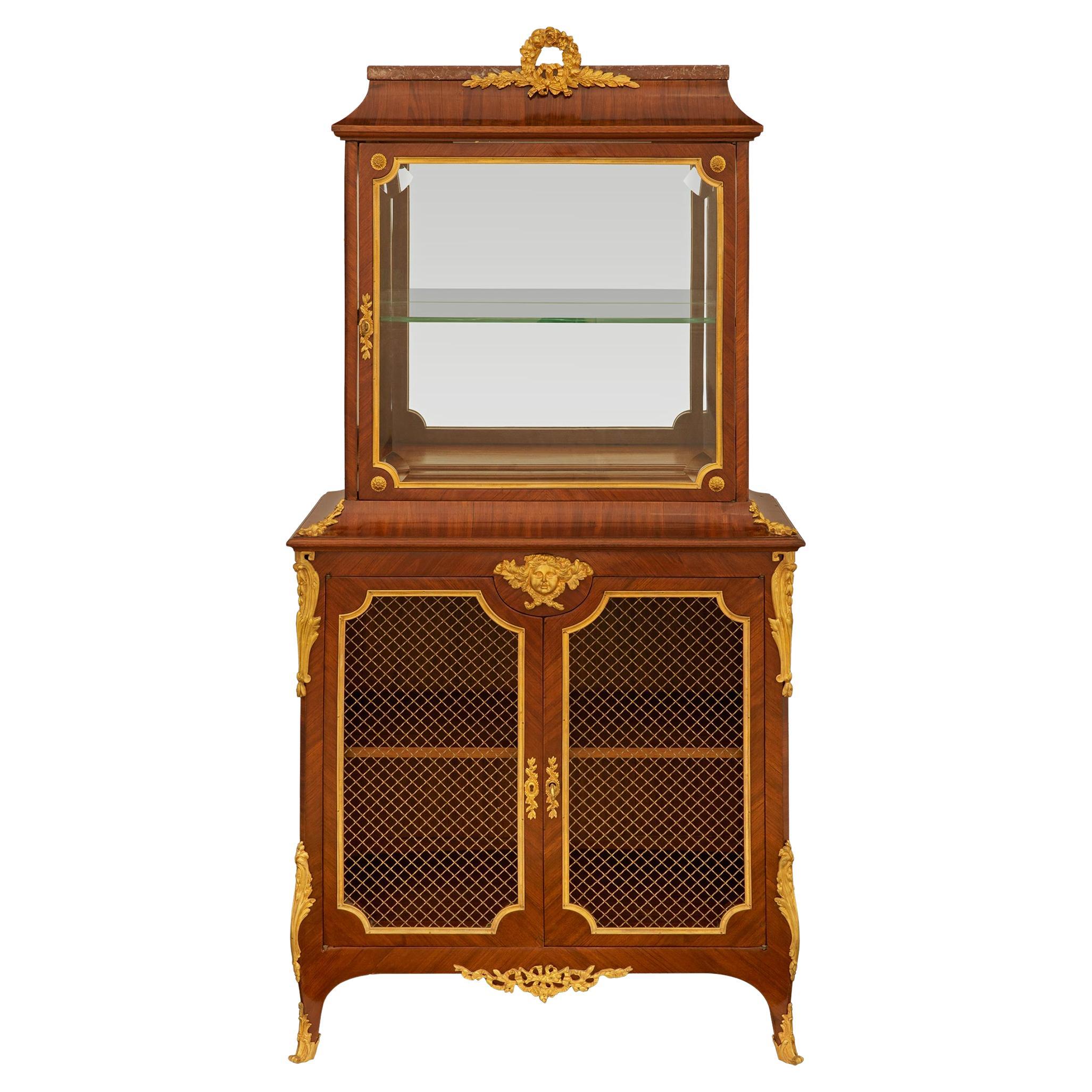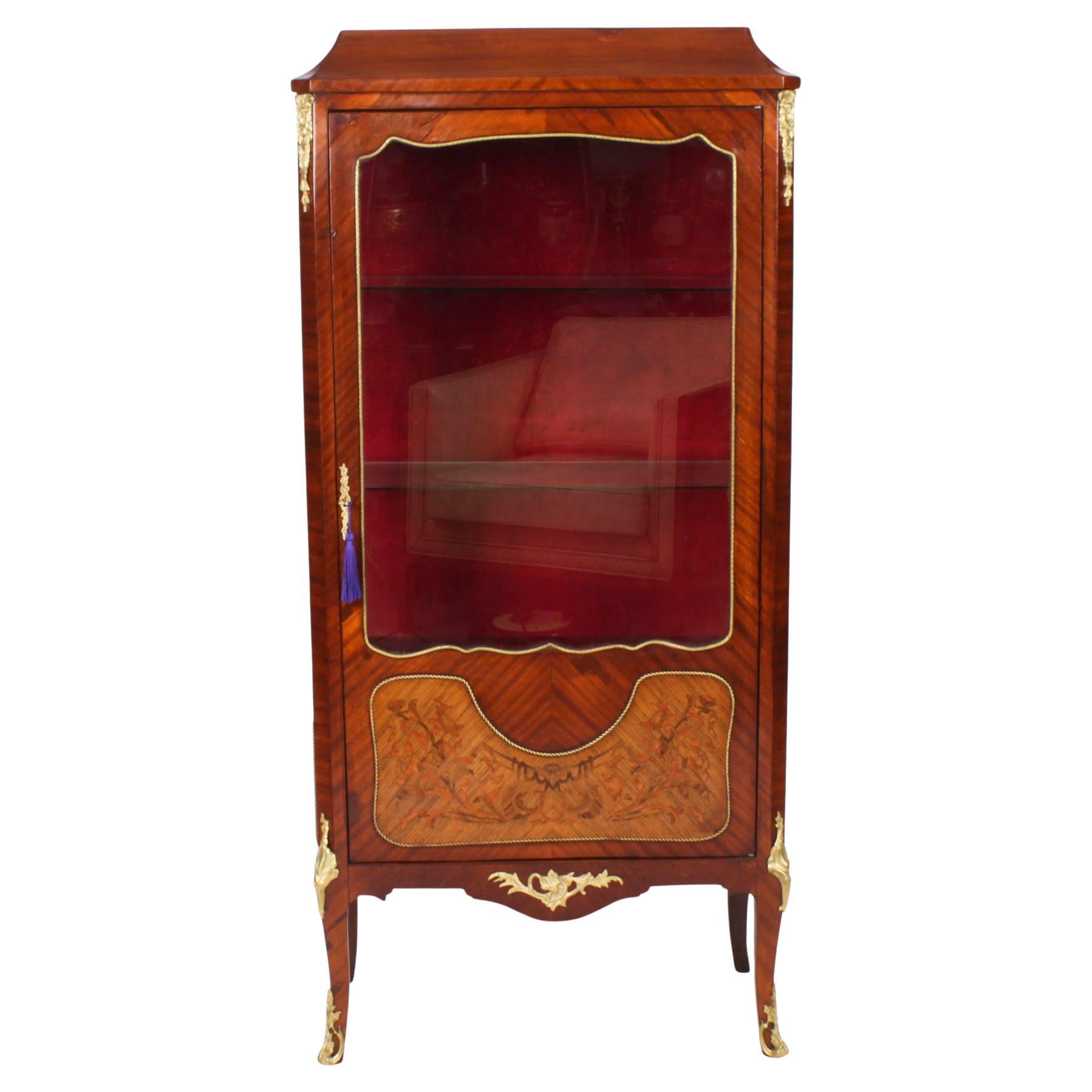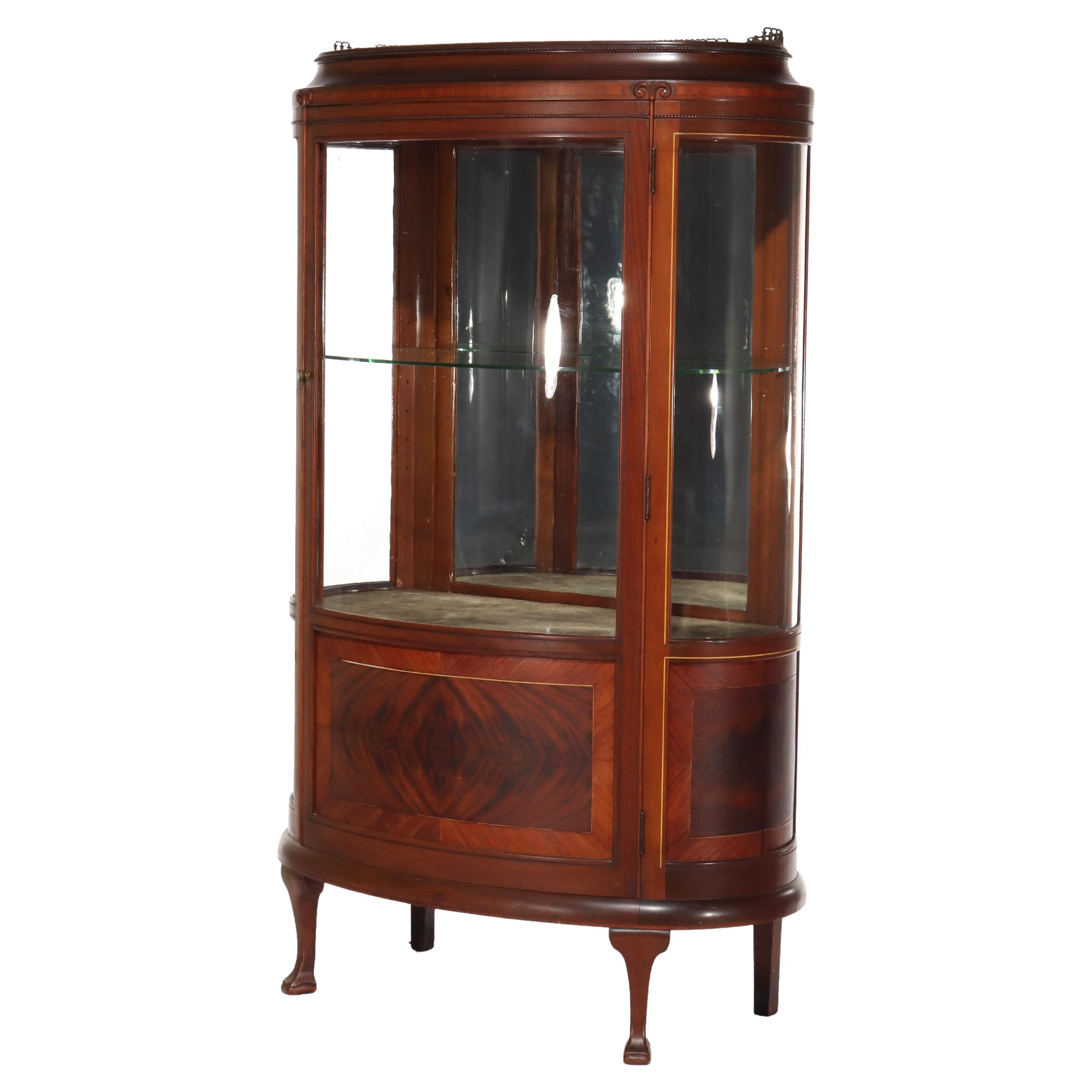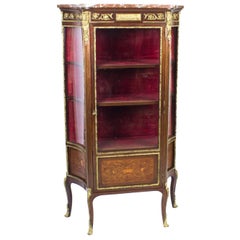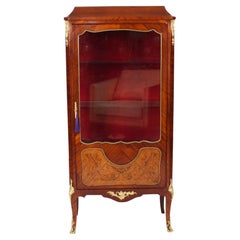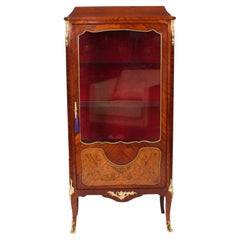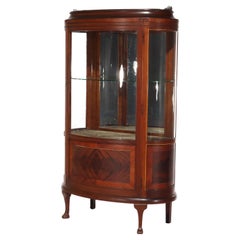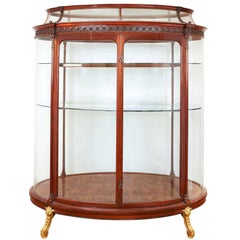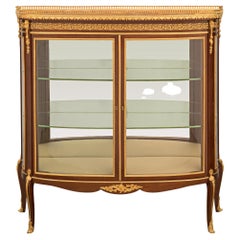Items Similar to Antique French Parquetry Ormolu Mounted Vitrine Cabinet 19th Century
Want more images or videos?
Request additional images or videos from the seller
1 of 20
Antique French Parquetry Ormolu Mounted Vitrine Cabinet 19th Century
$5,466.79
£3,950
€4,670.89
CA$7,482.83
A$8,381.16
CHF 4,361
MX$101,788.65
NOK 55,286.37
SEK 52,166.81
DKK 34,851.48
Shipping
Retrieving quote...The 1stDibs Promise:
Authenticity Guarantee,
Money-Back Guarantee,
24-Hour Cancellation
About the Item
This is a beautiful antique French Louis Revival parquetry and ormolu mounted breakront vitrine, circa 1860 in date.
This beautiful cabinet has exquisite parquetry and crossbanded decoration with gilded bronze ormolu mounts. The shaped breccia marble top and cornice above a glazed panelled door enclosing glass shelves, and raised on elegant shaped ormolu mounted feet.
Complete with working lock and key.
It will add a touch of unparalleled style to your home and is perfect for displaying your collection of silver or porcelain.
Condition:
In excellent condition having been beautifully cleaned and waxed in our workshops, please see photos for confirmation.
Dimensions in cm:
Height 158 x width 129 x depth 49
Dimensions in inches:
Height 5 foot, 2 inches x width 4 foot, 3 inches x depth 1 foot, 7 inches
Parquetry - is a geometric mosaic of wood pieces used for decorative effect. The two main uses of parquetry are as veneer patterns on furniture and block patterns for flooring. Parquetry patterns are entirely geometrical and angular—squares, triangles, lozenges.
The word derives from the Old French parchet , literally meaning "a small enclosed space". Large diagonal squares known as parquet de Versailles were introduced in 1684 as parquet de menuiserie to replace the marble flooring that required constant washing, which tended to rot the joists beneath the floors.
Such parquets en lozange were noted by the Swedish architect Daniel Cronström at Versailles and at the Grand Trianon in 1693. Timber contrasting in color and grain, such as oak, walnut, cherry, lime, pine, maple etc. are sometimes employed; and in the more expensive kinds sometimes other tropical hardwoods are also used.
Ormolu - Gilt Bronze (from French 'or moulu', signifying ground or pounded gold) is an 18th-century English term for applying finely ground, high-carat gold in a mercury amalgam to an object of bronze.The mercury is driven off in a kiln leaving behind a gold-coloured veneer known as 'gilt bronze'.
The manufacture of true ormolu employs a process known as mercury-gilding or fire-gilding, in which a solution of nitrate of mercury is applied to a piece of copper, brass, or bronze, followed by the application of an amalgam of gold and mercury. The item was then exposed to extreme heat until the mercury burned off and the gold remained, adhered to the metal object.
After around 1830 because legislation had outlawed the use of mercury other techniques were used instead. Electroplating is the most common modern technique. Ormolu techniques are essentially the same as those used on silver, to produce silver-gilt.
Breccia Marble
Is a rock composed of broken fragments of minerals or rock cemented together by a fine-grained matrix that can be similar to or different from the composition of the fragments.
Breccia rock can be any colour and is very colourful. The colour is determined by the colour of the matrix or cement along with the colour of the angular rock fragments.
The word has its origins in the Italian language, in which it means either "loose gravel" or "stone made by cemented gravel".
For thousands of years, the striking visual appearance of Breccias has made them a popular sculptural and architectural material. Breccia was used for column bases in the Minoan palace of Knossos on Crete in about 1800 BC. Breccia was used on a limited scale by the ancient Egyptians, one of the best-known examples is the statue of the goddess Tawaret in the British Museum.
It was regarded by the Romans as an especially precious stone and was often used in high-profile public buildings. Many types of marble are brecciated, such as Breccia Oniciata or Breche Nouvelle.
Breccia is most often used as an ornamental or facing material in walls and columns. A particularly striking example can be seen in the Pantheon in Rome, which features two gigantic columns of pavonazzetto, a breccia coming from Phrygia, in modern Turkey. Pavonazzetto obtains its name from its extremely colourful appearance, which is reminiscent of a peacock's feathers,pavone is "peacock" in Italian.
- Dimensions:Height: 62.21 in (158 cm)Width: 50.79 in (129 cm)Depth: 19.3 in (49 cm)
- Materials and Techniques:
- Place of Origin:
- Period:
- Date of Manufacture:circa 1860
- Condition:
- Seller Location:London, GB
- Reference Number:Seller: A20871stDibs: LU950624491192
About the Seller
5.0
Platinum Seller
Premium sellers with a 4.7+ rating and 24-hour response times
Established in 1983
1stDibs seller since 2012
1,368 sales on 1stDibs
Typical response time: <1 hour
Associations
LAPADA - The Association of Arts & Antiques Dealers
- ShippingRetrieving quote...Shipping from: London, United Kingdom
- Return Policy
Authenticity Guarantee
In the unlikely event there’s an issue with an item’s authenticity, contact us within 1 year for a full refund. DetailsMoney-Back Guarantee
If your item is not as described, is damaged in transit, or does not arrive, contact us within 7 days for a full refund. Details24-Hour Cancellation
You have a 24-hour grace period in which to reconsider your purchase, with no questions asked.Vetted Professional Sellers
Our world-class sellers must adhere to strict standards for service and quality, maintaining the integrity of our listings.Price-Match Guarantee
If you find that a seller listed the same item for a lower price elsewhere, we’ll match it.Trusted Global Delivery
Our best-in-class carrier network provides specialized shipping options worldwide, including custom delivery.More From This Seller
View AllAntique French Louis Revival Parquetry Display Cabinet 19th Century
Located in London, GB
This is a stunning antique French mahogany and ormolu-mounted display cabinet in the French Louis XV manner, circa 1870 in date.
This beautiful cabinet has an abundance of exquisite...
Category
Antique 1870s French Louis XV Cabinets
Materials
Marble, Ormolu
Antique Square Ormolu Mounted Vitrine Display Cabinet 19th Century
Located in London, GB
This is an exquisite antique French bois violette vitrine of square shaped form with glazed sides and fabulous ormolu mounts, circa 1880 in date.
This cabinet is elegantly crafted ...
Category
Antique 1880s Cabinets
Materials
Ormolu
Antique French Ormolu Mounted Walnut Display Cabinet Circa 1920
Located in London, GB
This is a stunning antique French Louis Revival ormolu mounted walnut and marquetry inlaid display cabinet, circa 1920 in date.
The cabinet features a shaped top and has impressive ...
Category
Vintage 1920s Cabinets
Materials
Walnut
Antique French Ormolu Mounted Walnut Display Cabinet Circa 1920
Located in London, GB
This is a stunning antique French Louis Revival ormolu mounted walnut and marquetry inlaid display cabinet, circa 1920 in date.
The cabinet features a shaped top and has impressive ...
Category
20th Century French Revival Cabinets
Materials
Ormolu
Antique French Vernis Martin Display Cabinet, 19th Century
Located in London, GB
This is a fabulous antique French Louis Revival Vernis Martin ormolu mounted display cabinet, circa 1880 in date.
This beautiful cabinet has hand painted decoration, exquisite ormolu mounts and a beautiful marble top. The central panel has a beautiful painting depicting a courting couple in a boat and the two side panels have paintings of country scenes.
The cabinet has serpentine glass to the sides with a capacious cupboard in the bottom.
Complete with working lock and original key.
The quality and attention to detail throughout is second to none.
Add a touch of unparalleled style to your home.
Condition:
In excellent condition having been beautifully cleaned polished and waxed in our workshops, please see photos for confirmation.
Dimensions in cm:
Height 160 x width 88 x depth 34
Dimensions in inches:
Height 5 foot, 3 inches x width 2 foot, 11 inches x depth 1 foot, 1 inch
Vernis Martin is a lustrous lacquer substitute widely used in the 18th century to decorate furniture and such personal articles as brisé fans...
Category
Antique 1880s French Cabinets
Materials
Marble, Ormolu
Antique Large French Vernis Martin Display Cabinet C1880 19th Century
Located in London, GB
A stunning antique Louis XV Revival French Vernis Marten five panel display cabinet of extravagantly shaped serpentine form, Circa 1880 in date, with exquisite hand painted decoratio...
Category
Antique 1880s Cabinets
Materials
Other
You May Also Like
French 19th century Tulipwood, Ormolu and Marble vitrine cabinet
Located in West Palm Beach, FL
An elegant and high quality French 19th century Transitional st. Tulipwood, Ormolu and Marble vitrine cabinet. This handsome cabinet is raised by Tulipwood cabriole legs fitted with ...
Category
Antique 19th Century French Vitrines
Materials
Marble, Ormolu
Antique French Mahogany Banded Display Vitrine With Inlay & Ormolu C1890
Located in Big Flats, NY
***Reduced In-House Delivery Rates - Click on “Ask Seller” to Request a Quote***
Antique French Mahogany Banded Display Vitrine With Inlay & Ormolu C1890 (62 1/4" x 36" x 18").
T...
Category
Antique Late 19th Century Cabinets
Materials
Mahogany
$1,440 Sale Price
20% Off
French Golden Ormolu-Mounted Brown Mahogany and Parquetry Large Antique Vitrine
Located in London, GB
The vitrine oval shaped, with central hinged tall doors to the front and glazed display all around, mounted with ormolu handles and short legs.
Category
Antique 19th Century French Victorian Vitrines
Materials
Bronze
French 19th Century Transitional St. Mahogany and Ormolu Vitrine
Located in West Palm Beach, FL
A superb and most elegant French 19th century Transitional st. Mahogany, ormolu and Brèche d'Alep marble cabinet vitrine. The two door vitrine is raised by four slender cabriole legs...
Category
Antique 19th Century French Vitrines
Materials
Marble, Ormolu
Antique Quality Kingwood Ormolu Mounted French Vernis Martin Display Cabinet
Located in Suffolk, GB
19th century antique quality kingwood and ormolu mounted French Vernis Martin display cabinet
having an attractive shaped top with an impressiv...
Category
Antique 1860s French Victorian Cabinets
Materials
Ormolu
French Display Cabinet Vitrine Marquetry Inlay, 1860
Located in Potters Bar, GB
Pretty french rosewood inlaid side cabinet.
circa 1860
This cabinet is raised upon turned bun feet.
Featuring 2 doors.
The lower panels of the doors featuring pretty marquetry in...
Category
Antique 1860s Cabinets
Materials
Rosewood
More Ways To Browse
Ormolu Mounted French
Gilt Ormolu Mount Furniture
French Gilt Ormolu Mount
French Ormolu Cabinets
Small French Storage Cabinet
Antique Cabinet Gold
French Metal Cabinets
Antique Ormolu Mounts
Gold French Cabinet
Antique French Ormolu Mounts
Antique Silver Cabinet
French Brass Ormolu
Small Marble Cabinet
Antique 2 Piece Cabinets
Gold Metal Cabinets
Mounted Minerals
Display Cabinet Ormolu
Small Wood Cabinet Glass Doors

